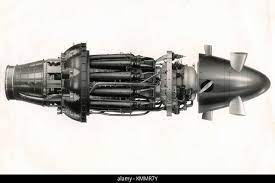Armstrong Siddeley Python

The Python turboprop engine was designed and built by Armstrong Siddeley and was developed from the earlier Armstrong Siddeley ASX turbojet engine that was developed in 1943 but was deemed to be surplus to requirements and the design was adapted into a turboprop design named Python. It powered the Westland Wyvern an aircraft carrier-based fighter aircraft, with the 4,110 ehp Python turboprop engine replacing the Wyvern prototype's original Rolls Royce Eagle 22 piston engine.
Early flight testing of the Python was carried out using Lancaster TW911 and Lincoln RE339/G, each aircraft having the two outboard Merlin piston engines replaced by Python turboprop engines. Lincoln B 2, RF403 was used for high altitude bombing trials at the Woomera range in South Australia with two Python engines installed to increase the Lincoln's high altitude capabilities to a figure that would allow the tests to be carried out.
The Museum's Python is assumed to be an engine associated with the operation of the Python Lincolns at Woomera
Early flight testing of the Python was carried out using Lancaster TW911 and Lincoln RE339/G, each aircraft having the two outboard Merlin piston engines replaced by Python turboprop engines. Lincoln B 2, RF403 was used for high altitude bombing trials at the Woomera range in South Australia with two Python engines installed to increase the Lincoln's high altitude capabilities to a figure that would allow the tests to be carried out.
The Museum's Python is assumed to be an engine associated with the operation of the Python Lincolns at Woomera
|
TECHNICAL DATA
Compressor Combustors Turbine Maximum Power Weight |
14 stage, axial flow 11 combustion chambers Two stage axial flow 4,110 EHSP (2,930 shp + 1,180 lbs exhaust thrust) 3,450 lbs (1,565kgs) |
